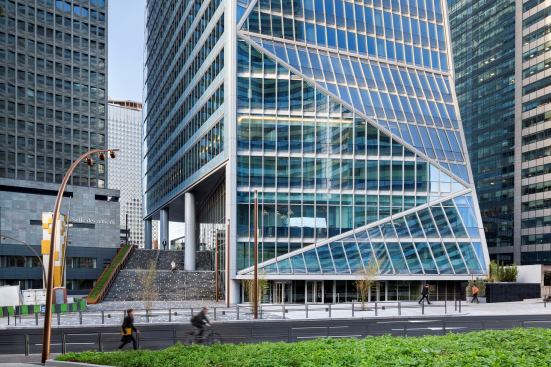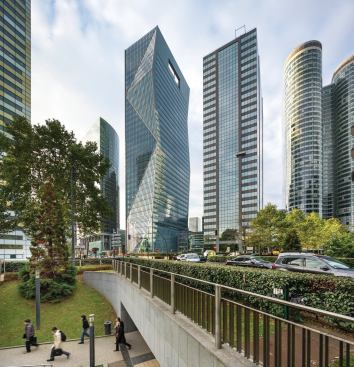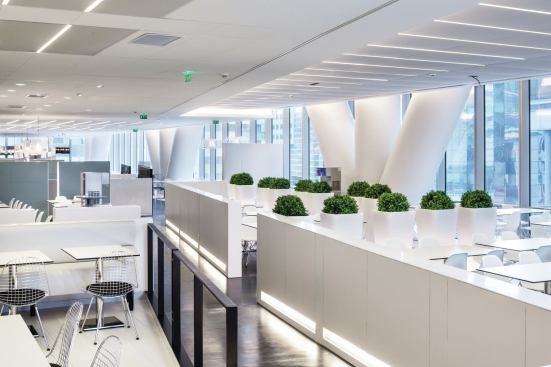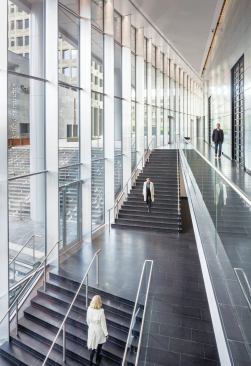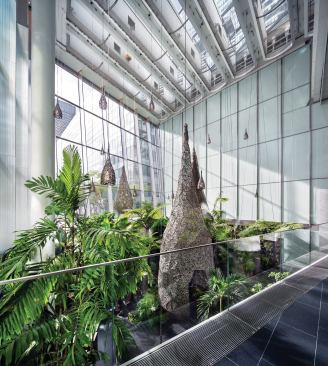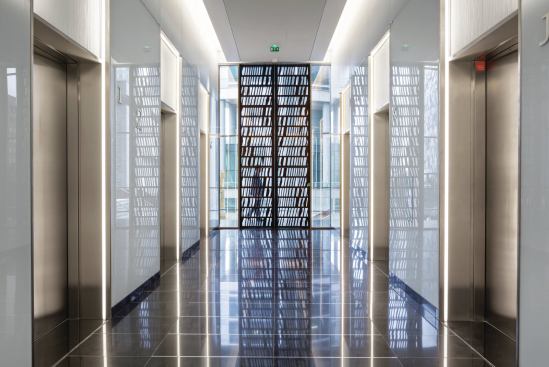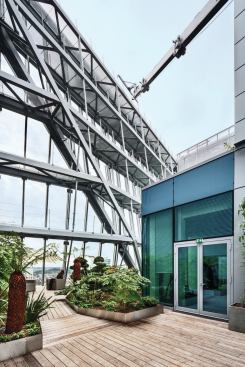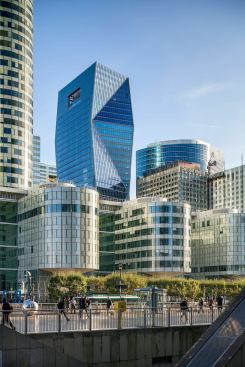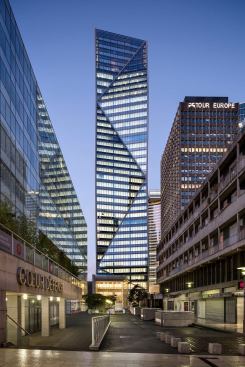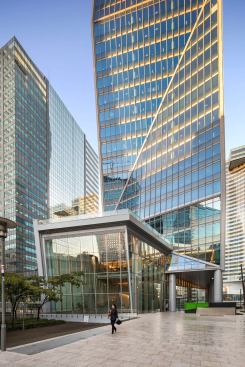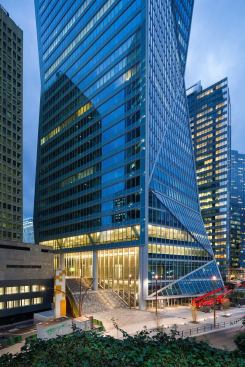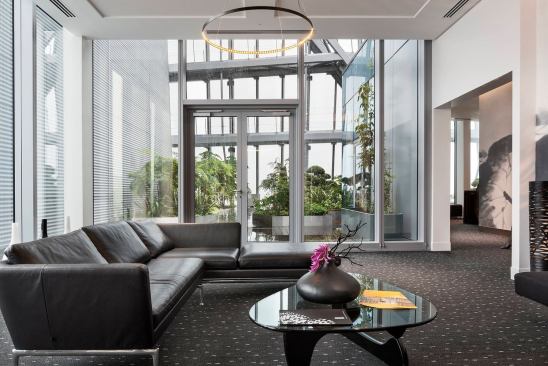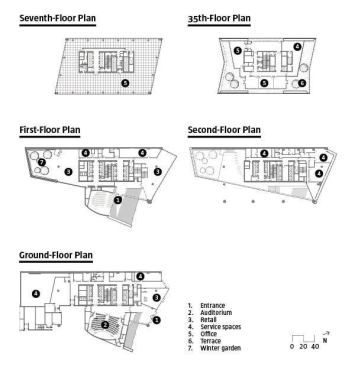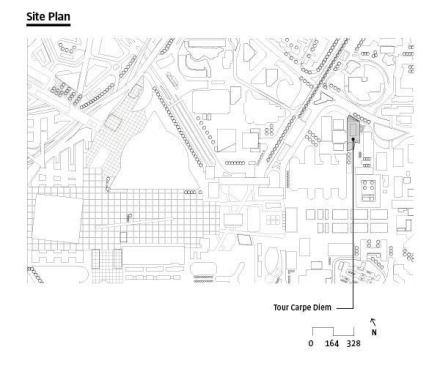Project Description
You don’t expect an architect to compare a 38-story office building he co-designed to Marcel Duchamp’s 1912 Nude Descending a Staircase (No. 2),
the painting that caused such a scandal when it brought cubism to
America in the 1913 Armory Exhibition. That is especially true if the
architect is an American, the tower is in Paris, and he is a partner at
New York–based Robert A.M. Stern Architects (RAMSA),
the firm most of us associate with polite and expensive Neo-Classicism.
Yet RAMSA partner Kevin Smith, AIA, who—together with fellow partner
Meghan McDermott, AIA—designed the recently opened 489,700-square-foot
Tour Carpe Diem, insists that this is “a cubist building—and a bit of an
anthropomorphic one.”
The tower, a speculative development for insurance company
Aviva
in Paris’s La Défense district, is modernist in its skin and bones, as
well as in its site and siting. The latter is the main reason for the
building’s slickness and vivaciousness: It is located in the area that
the French have built up, since the 1960s, into the largest office
complex in Europe (comprising almost 60 million square feet). Dozens of
isolated office towers stand on a large plinth (or
dalle), known as “the Pear” because of its shape, which sits
at the end of the same axis as the Arc de Triomphe and the Louvre. The
plinth, in high modernist fashion, contains all of the services that get
people in and out by car or train, not to mention mechanical and trash
services. In recent years, the
Établissement Public pour l’Aménagement de la Région de la Défense
(EPAD), the agency that runs the district, has tried to humanize this
pedestrian environment and lunchtime eating and shopping area by
renovating the few housing blocks in the area, but it remains a fortress
of big business.
Carpe Diem is, in fact, the first building to break out of the Pear’s
confines by adding a stair connecting the plinth to the adjacent
neighborhood, Courbevoie. “Everything comes from that diagonal
connecting the dalle to the neighborhood for the first time,”
Smith says. “The diagonal offsets of the north and south façades, and
the public interiors make visible that cut.”
The zigzags of the short façades are what define the Carpe Diem. Smith
and McDermott designed them both to break down the building’s mass, and
to provide the structure with an identity. They also ensure “that the
tower always looks different, depending from where you see it, and what
the light is like,” McDermott says. “We wanted it to come alive in this
otherwise rather dead setting, even in gray weather.”
The architects, who developed the design for a competition in 2008,
responded both to the specific and the general context. “As Americans
coming to Paris,” Smith says, “we picked up not just on the art that
helped change our culture, but also on the diagonals hidden in French
architecture: the struts in the Eiffel Tower and inside the Statue of
Liberty, Eugène Viollet-le-Duc’s constructions, and even the boulevards
crossing Paris.”
This responsiveness to both the specific and the general site continued
in the designers’ choice of glass. “We wanted something that was more
blue-silver than bronze or green, so that it would dissolve into the sky
from some angles, while being transparent from others,” McDermott says.
They gave the folded, short sides shadow boxes for the moldings to
emphasize the building’s mass, while making the long sides sleek and
transparent to maximize views and lighten the building’s mass.
Within this acrobatic mass, Carpe Diem’s public spaces open up its
narrow site at ground level, while expanding the views at the top. “We
really wanted to emphasize and strengthen the new connection,” Smith
says, pointing to the broad stairs that run up to the dalle
both inside and outside the building. The opening in the plinth “was a
request from Courbevoie and EPAD,” says Joelle Chauvin, the managing
director of Aviva Investors Real Estate France, and the project’s
client. “But what was wonderful was the way Stern responded, with this
grand staircase both inside and out, that really made a wonderful sense
of drama and ease out of the connection—it is superb.”
The tower has two front doors, one at the street and one on the plinth.
In addition to the employee cafeteria on the ground floor and a full
restaurant on the second floor for the 3,000 employees who will work in
the building (a number that was mandated by French law), the developer
also asked for an “oasis” within the “stone world of La Défense.” They
wanted “something more ancient and still within the mineral and modern
world of La Défense,” Smith says. Smith’s and McDermott’s response, in
collaboration with landscape architect Ronan Gallais of Mutabilis, was a
sunken winter garden, complete with a green wall, filled with both real
vines and bronze ones created by the artist Stéphanie Buttier. “The
winter garden was my idea,” Chauvin says. “It is a bit of theater. Now,
it is also a place for relaxation.” An adjacent spa facility increases
the possibilities to retreat in this cavern rescued from the tangle of
service tunnels and mechanical equipment stowed in the plinth all around
it.
The public space reappears at the tower’s top. Carpe Diem’s roof is a
garden where employees can take in the air and the views over Paris
while remaining sheltered behind the glass façade that continues up past
them. Equally lavishly planted, this space is the active and
outward-looking counterpart to the base’s junglelike garden. Here,
adjacent meeting rooms that resident firms can book are the alternative
to the base’s place of isolation and relaxation.
In-between all these generous spaces, 14,000-square-foot floors stack
up. They are relatively small, at least by American standards, but the
eccentric loading of the core to the west allows for large expanses on
the building’s more light-filled eastern side, while the western side
accommodates private offices along a fire corridor. As the facets only
occur on the two narrow sides that are visible from the surroundings,
creating dramatic corner conditions, the long faces remain more
workmanlike and efficient. The floors also have 9-foot clear ceiling
heights and no interior columns (a rarity in French office buildings),
in order to allow for the most flexible use.
For all of its fracturing of the glass office tower and addition of
places of circulation, or just hanging out, in a manner that ameliorates
the sameness inherent in the modern office tower, Carpe Diem’s most
remarkable achievement remains invisible. A combination of factors—the
glass façade’s angles and its surface performance, the building’s
orientation, computer-assisted shading and energy distribution, on-site
ice storage, recycling of rainwater collected from the roof garden,
chilled beams in the office floors, use of La Défense’s central steam
heat for standard energy loads (letting internal heating and cooling
manage peaks), low general lighting combined with high-performance task
lights, bicycle parking, and, last not but not least, geothermal
wells—means that this building achieved both LEED Platinum status and
its French equivalents, the designations of a Bâtiment de basse consommation (Building with low usage) and Très haute performance énergétique
(Very high energy performance). “If it wasn’t for some peculiarities in
the local code,” Smith says, “we could have made this a net-zero energy
building.”
In its appearance, in the way it opens up its public spaces at every
level, and in the way it works, Tour Carpe Diem is a model of a
light-footed office building. “The way Kevin and Meghan developed the
design was very chic and free,” Chauvin says, “but also new and
energetic.” Against the closed boxes that surround it, but also in
contrast to RAMSA’s more closed constructions, this is a structure that
continues the modernist dream that architecture should reflect, refract,
and open up the world around it, using the latest technology to make us
both more comfortable and more at home in a world many see as alien. In
one of the world’s most maligned bastions of modernism, this denuding
of the modernist traditions is ascending, rather than descending,
towards a vision that is, in however incremental a way, more pleasant
and hopeful than the one that came before. —Aaron Betsky
CORRECTION: In a previous version of this article, Robert A.M.
Stern Architects was misidentified as Robert A.M. Stern Associates. We
regret the error.
